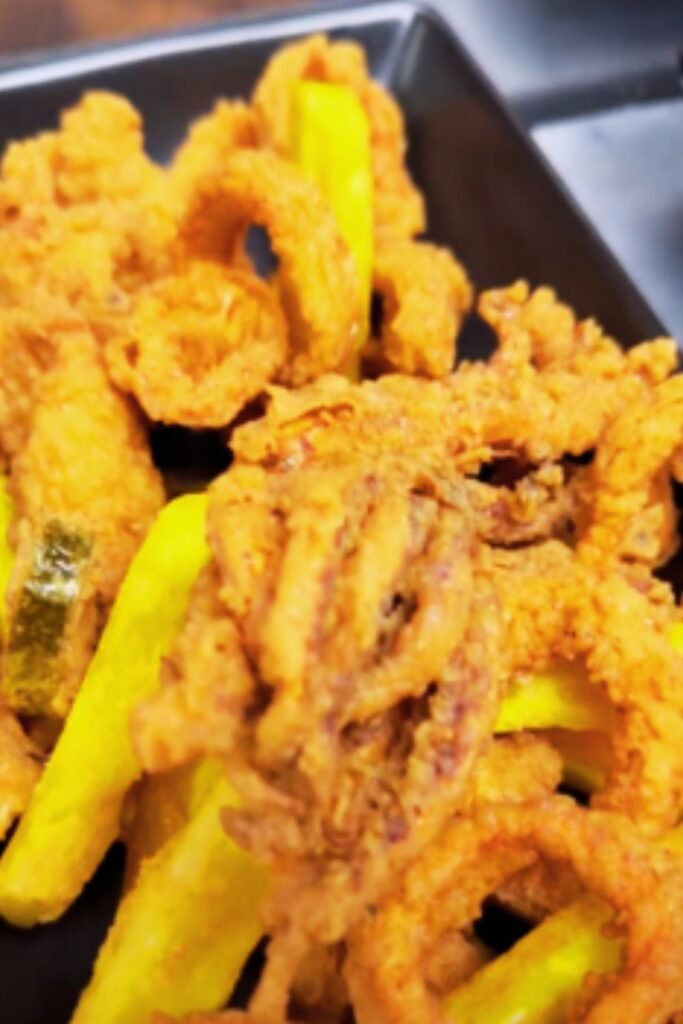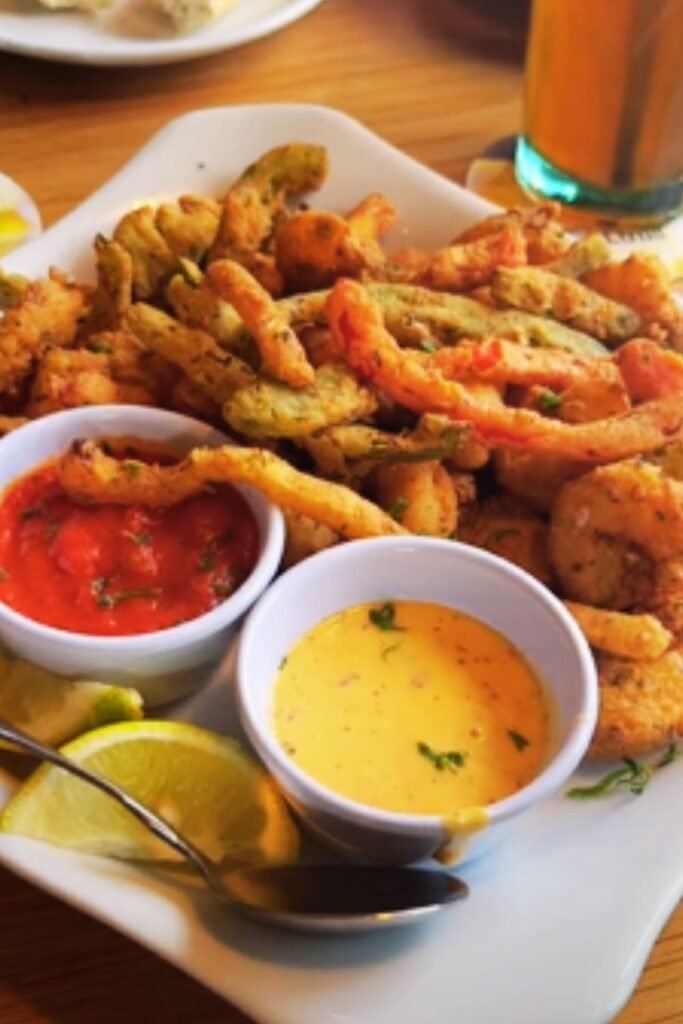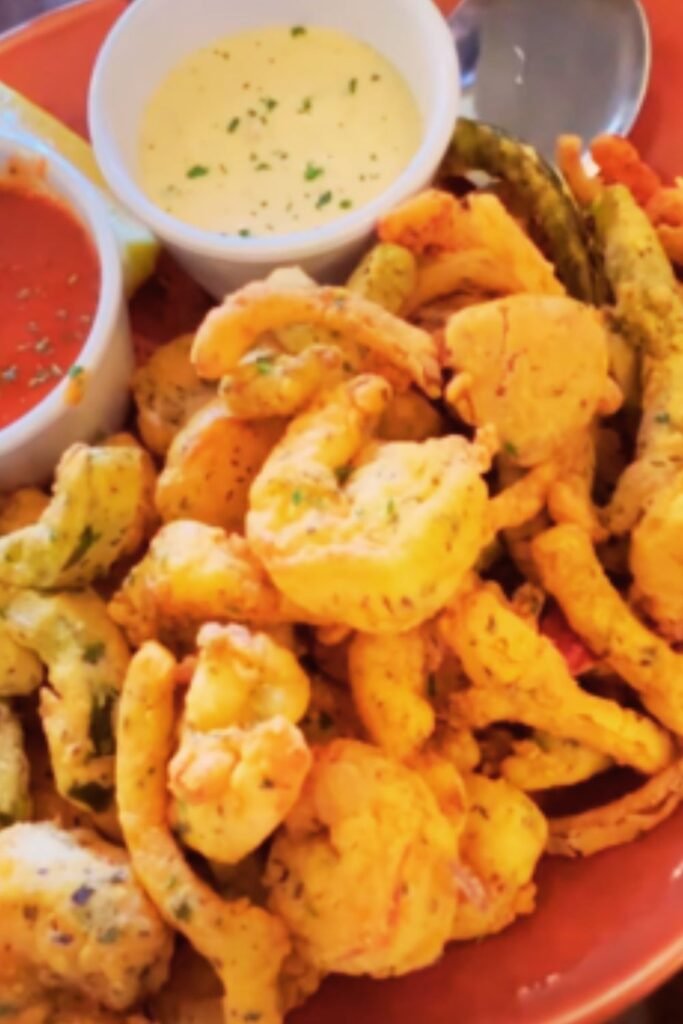There’s something undeniably magical about the sound of fresh seafood hitting hot oil, the enticing aroma that fills the kitchen, and that first satisfying crunch when you bite into perfectly crispy fritto misto. As someone who’s spent years perfecting the art of Italian appetizers, I can confidently say that Shrimp Fritto Misto stands as one of the most impressive yet approachable dishes in the Italian seafood repertoire.
This classic Italian antipasto—literally meaning “mixed fried” in Italian—transforms fresh shrimp and a medley of vegetables into a golden, crispy delight that never fails to impress guests. Whether you’re hosting a dinner party or simply treating yourself to something special, this dish delivers restaurant-quality results with surprising ease.
In this comprehensive guide, I’ll walk you through everything you need to know about creating the perfect Shrimp Fritto Misto at home, from selecting the freshest ingredients to achieving that perfectly light, crispy batter that Italian cuisine is famous for. Let’s dive in!
The Rich History of Fritto Misto
Fritto misto has humble origins in coastal Italian regions, where fishermen would bring home their smaller catches—the ones too tiny to sell at market—and fry them up as a simple family meal. This practice of “frying the mixed catch” eventually evolved into the beloved appetizer we know today.
In northern Italy, particularly Venice, fritto misto di mare (mixed fried seafood) became a staple on restaurant menus, featuring everything from small fish to calamari and, of course, plump shrimp. The southern Italian version, especially popular in Campania and Sicily, often incorporates more vegetables alongside the seafood.
What makes shrimp particularly special in this mix is their sweet flavor and tender texture that perfectly complements the crispy exterior. When prepared correctly, shrimp fritto misto balances delicate seafood flavors with satisfying crunch—the ultimate contrast in textures.
Essential Ingredients for Perfect Shrimp Fritto Misto
The beauty of fritto misto lies in its simplicity and quality ingredients. Here’s what you’ll need to gather:
For the Seafood:
- 1 pound medium-sized shrimp (16-20 count), peeled and deveined, tails on
- 1/2 pound calamari rings and tentacles (optional)
- 12 small bay scallops (optional)
For the Vegetables:
- 1 medium zucchini, sliced into 1/4-inch rounds
- 1 small eggplant, sliced into 1/4-inch rounds
- 1 fennel bulb, sliced thinly
- 8-10 fresh sage leaves
- 1 lemon, sliced into thin rounds, seeds removed
- 8-10 asparagus spears, woody ends removed and cut in half
For the Batter:
- 2 cups all-purpose flour
- 1 cup cornstarch
- 1 teaspoon baking powder
- 1 teaspoon salt
- 1/4 teaspoon freshly ground black pepper
- 2 cups ice-cold sparkling water
- Ice cubes (to keep the batter cold)
For Serving:
- Lemon wedges
- Flaky sea salt
- Fresh parsley, chopped
- Aioli or marinara sauce for dipping
The Secret to Perfect Fritto Misto Batter

The difference between mediocre and magnificent fritto misto lies largely in the batter. After years of experimenting, I’ve found that a light, effervescent batter creates that delicate, crispy coating that makes this dish special.
The key principles for perfect batter include:
Temperature Control
Always use ice-cold sparkling water and maintain the batter’s temperature by nesting your batter bowl in another bowl filled with ice. This prevents gluten development and ensures a crispy rather than doughy result.
Minimal Mixing
Mix the dry ingredients thoroughly, but when adding the liquid, stir just until combined. A few small lumps are actually preferable to overmixing, which can make the batter heavy.
Proper Consistency
The batter should be slightly thinner than pancake batter—when you lift a spoon, it should coat the back and run off in a ribbon. If it’s too thick, add a touch more sparkling water; if too thin, add a little more flour.
Last-Minute Preparation
For optimal results, prepare your batter right before frying. This keeps the carbonation from the sparkling water active, resulting in a lighter texture.
Step-by-Step Preparation Method
Preparing the Seafood and Vegetables
- Shrimp Preparation:
- Pat the shrimp completely dry with paper towels
- If keeping tails on (recommended for presentation), make sure they’re clean and dry
- Score the underside of larger shrimp lightly to prevent curling during frying
- Vegetable Preparation:
- Slice all vegetables to uniform thickness (about 1/4 inch) for even cooking
- Salt the eggplant slices and let sit for 15 minutes, then pat dry to remove excess moisture
- Arrange all ingredients on a baking sheet lined with paper towels
Making the Perfect Batter
- In a large bowl, whisk together the flour, cornstarch, baking powder, salt, and pepper.
- Place this bowl inside another larger bowl filled with ice cubes to keep the batter cold.
- When ready to fry, gradually whisk in the ice-cold sparkling water until just combined. The batter should be thin enough to coat ingredients without being too runny.
- Do not overmix—a few small lumps are fine and will create a light, airy texture.
The Frying Process

- Oil Selection and Temperature:
- Use neutral oil with a high smoke point like sunflower, canola, or peanut oil
- Fill a heavy Dutch oven or deep pot with 3 inches of oil
- Heat to 350-360°F (175-180°C)—use a deep-fry thermometer for accuracy
- Maintain this temperature throughout cooking
- Battering and Frying Technique:
- Work in small batches to avoid overcrowding and temperature drops
- Dip each piece into the batter, letting excess drip off
- Carefully lower into the hot oil
- Fry shrimp for about 2-3 minutes until golden and crisp
- Fry vegetables according to density (denser vegetables take longer)
- Proper Draining:
- Remove with a spider strainer or slotted spoon
- Drain on paper towels or a wire rack
- Season immediately with flaky sea salt while still hot
Frying Sequence for Best Results
For optimal results, fry ingredients in this order:
- Vegetables first (eggplant, zucchini, fennel, asparagus)
- Lemon slices and sage leaves (these cook very quickly)
- Seafood last (calamari if using, followed by scallops if using, then shrimp)
This sequence prevents the seafood flavors from permeating the oil too early and ensures everything is served at its freshest.
Temperature Control: The Most Critical Factor
Maintaining proper oil temperature is absolutely crucial for fritto misto success. Here’s why:
| Temperature Range | Effect on Food | Troubleshooting |
|---|---|---|
| Below 325°F (160°C) | Soggy, oil-soaked result | Add more oil or wait longer before adding next batch |
| 350-360°F (175-180°C) | Perfect golden, crispy exterior | Ideal temperature range |
| Above 375°F (190°C) | Outside burns before inside cooks | Remove from heat briefly to cool oil |
Between batches, allow the oil to return to the target temperature before adding more food. Use a candy or deep-fry thermometer for accuracy—this small investment dramatically improves results.
Serving Suggestions for Shrimp Fritto Misto

The beauty of fritto misto is that it should be served immediately while still hot and crispy. Here’s how to present it at its best:
Plating Techniques:
- Serve on a platter lined with parchment paper or a clean kitchen towel to absorb any excess oil
- Arrange in a loose pile rather than stacking to maintain crispness
- Garnish with additional fresh herbs and lemon wedges
Accompanying Dipping Sauces:
- Classic lemon aioli (mayonnaise, lemon juice, garlic, and herbs)
- Spicy marinara sauce
- Salsa verde (Italian green herb sauce)
- Simple lemon wedges for a bright, acidic contrast
Complete the Meal:
- Light, crisp green salad with a simple vinaigrette
- Crusty Italian bread
- Fresh fruit sorbet for dessert
- Sparkling water with lemon
Troubleshooting Common Fritto Misto Problems
Even experienced cooks encounter challenges with fried foods. Here are solutions to common issues:
Soggy Rather Than Crispy Results:
- Oil temperature too low
- Batter too thick
- Not draining properly after frying
- Overcrowding the pot
Batter Falling Off:
- Food not dry enough before battering
- Batter too thin
- Oil not hot enough
Burnt Exterior With Raw Interior:
- Oil temperature too high
- Pieces cut too thick
- Batter too thick
Greasy Final Product:
- Oil not hot enough
- Improper draining
- Not serving immediately
Regional Variations of Fritto Misto
Across Italy, you’ll find fascinating regional adaptations of this classic dish:
Venetian Style:
In Venice, fritto misto di mare often includes small whole fish and moleche (soft-shell crabs) alongside the shrimp and calamari, typically served with polenta.
Ligurian Approach:
The Ligurian version might incorporate anchovies and local herbs like marjoram, with a lighter batter.
Sicilian Influence:
In Sicily, you might find fritto misto seasoned with lemon and served with a side of caponata—a sweet and sour eggplant dish.
My Personal Adaptation:
My favorite version combines the best of traditional approaches with a few modern touches: a super-light batter made with sparkling water and a touch of vodka (which evaporates quickly for extra crispness), and a lemon-herb aioli for dipping.
Making Fritto Misto Ahead of Time
While fritto misto is best enjoyed fresh from the fryer, there are ways to prepare components ahead for entertaining:
- Pre-Prep Vegetables: Clean and slice all vegetables up to 24 hours ahead. Store them in the refrigerator between layers of paper towels in an airtight container.
- Clean Seafood Early: Peel and devein shrimp several hours ahead, but keep refrigerated until ready to cook.
- Measure Dry Ingredients: Combine the flour, cornstarch, baking powder, salt, and pepper ahead of time.
- Prepare Dipping Sauces: Make sauces a day ahead—flavors will actually improve overnight.
- Set Up Frying Station: Arrange your draining setup, thermometer, and tools before guests arrive.
Just remember to only mix the batter right before frying and serve immediately after cooking.
Health Considerations and Lighter Alternatives
Traditional fritto misto is undeniably a special occasion dish, but there are ways to create a lighter version:
Air Fryer Adaptation:
While not traditional, an air fryer can produce a satisfying version with significantly less oil. Spray the battered items lightly with oil before air frying at 400°F (200°C) for about 6-8 minutes.
Oil Selection:
Using high-quality oils like extra virgin olive oil (despite the higher cost) can provide better nutritional value and flavor.
Serving Size:
Consider serving fritto misto as a shared appetizer rather than a main course, paired with vegetable-forward sides.
Nutritional Information
For those tracking nutritional content, here’s an approximate breakdown per serving (assuming 6 servings from this recipe):
| Nutrient | Amount |
|---|---|
| Calories | 320 kcal |
| Protein | 18g |
| Carbohydrates | 32g |
| Fat | 14g |
| Fiber | 3g |
| Sodium | 450mg |
Note: These values vary based on exact ingredients and oil absorption, which depends on frying technique and temperature.
Questions and Answers
Q: Can I prepare the batter in advance? While you can mix the dry ingredients ahead of time, the batter itself should be prepared just before frying. The carbonation from the sparkling water creates those desirable air bubbles that make for a light, crispy coating, but these dissipate quickly.
Q: What’s the best oil for frying fritto misto? For authentic Italian flavor, a blend of olive oil and sunflower oil works wonderfully, though many Italian chefs use pure sunflower or peanut oil for its high smoke point and neutral flavor. Avoid extra virgin olive oil for frying, as it has a low smoke point and becomes bitter when overheated.
Q: How do I know when the shrimp are perfectly cooked? Properly cooked shrimp turn from translucent to opaque pink with bright red accents. In the hot oil, this typically takes just 2-3 minutes. They should form a slight C-shape when done—if they curl into a tight O-shape, they’re overcooked.
Q: Can I reuse the oil after making fritto misto? Yes, but with some precautions. Let the oil cool completely, then strain through a fine-mesh sieve lined with cheesecloth to remove all food particles. Store in a clean, airtight container away from light and heat. I wouldn’t use it more than once more, especially after frying seafood.
Q: What can I substitute for the sparkling water? If you don’t have sparkling water, a light beer works surprisingly well and adds a pleasant flavor. For a non-alcoholic alternative, a mixture of still water with 1 teaspoon of baking soda can create similar airiness.
Q: How do I prevent the batter from getting soggy quickly after frying? Serving immediately is key, but if you need to make multiple batches, keep the finished pieces warm in a single layer on a wire rack in a 250°F (120°C) oven. Never cover fried food with foil or stack pieces, as this traps steam and destroys the crispy texture.
Q: Is there a gluten-free alternative for the batter? Absolutely! Replace the all-purpose flour with a gluten-free flour blend and add 1/4 teaspoon of xanthan gum for binding. Rice flour or cornstarch-based batters also work exceptionally well and often result in an even crispier finish.
Q: What’s the best way to dispose of used frying oil? Never pour oil down the drain. Once completely cooled, transfer to a sealed container and dispose according to local regulations. Many communities have collection sites for cooking oil recycling.
Final Tips for Fritto Misto Success

After years of preparing this dish, I’ve gathered these final nuggets of wisdom:
- Salt Timing: Always salt fried food immediately after removing from oil when it’s still hot—this helps the salt adhere better.
- Serve with Acid: The rich, fried nature of fritto misto begs for acidic accompaniments—lemon wedges, pickled vegetables, or a vinegar-based dipping sauce cut through the richness perfectly.
- Fresh Oil: While it’s tempting to economize, using fresh oil makes a significant difference in flavor and prevents off-tastes.
- Test First: Before committing your precious shrimp to the oil, test the batter and temperature with a small piece of bread or vegetable.
- Double-Frying Technique: For extra-crispy results, some chefs use a double-frying method—first at a lower temperature (325°F/160°C) just until cooked through, then a quick second fry at higher temperature (375°F/190°C) to crisp the exterior.
Shrimp Fritto Misto represents the perfect marriage of simple ingredients and careful technique. The delicate sweetness of shrimp encased in an airy, crisp coating, complemented by the natural sweetness of vegetables transformed by the frying process—it’s a dish that demonstrates how Italian cuisine elevates straightforward cooking to an art form.
Whether you’re serving it as part of an antipasti spread or as the star of the show, mastering this classic will add a touch of coastal Italian elegance to your cooking repertoire. With practice, you’ll develop an intuitive feel for the perfect batter consistency and frying temperature that will make your fritto misto legendary among friends and family.
Remember, the essence of great Italian cooking isn’t complexity but respect for ingredients and technique. Take your time, enjoy the process, and you’ll create a fritto misto that would make any Italian nonna proud!


